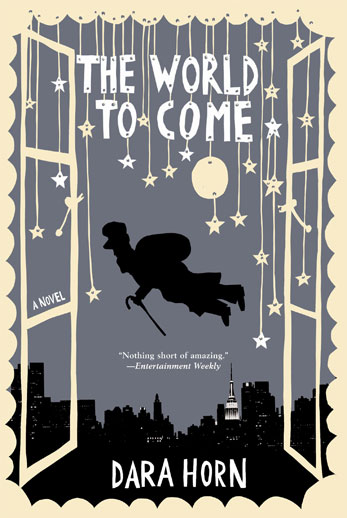
THE WORLD TO COME
A million-dollar painting by Marc Chagall is stolen from a museum. The unlikely thief is Benjamin Ziskind, a thirty-year-old quiz-show writer. As Benjamin and his twin sister try to evade the police, they find themselves recalling their dead parents—the father who lost a leg in Vietnam, the mother who created children’s books—and their stories about trust, loss, and betrayal.
What is true, what is fake, what does it mean? Eighty years before the theft, these questions haunted Chagall and the enigmatic Yiddish fabulist Der Nister (“The Hidden One”), teachers at a school for Jewish orphans. Both the painting and the questions will travel through time to shape the Ziskinds’
A million-dollar painting by Marc Chagall is stolen from a museum. The unlikely thief is Benjamin Ziskind, a thirty-year-old quiz-show writer. As Benjamin and his twin sister try to evade the police, they find themselves recalling their dead parents—the father who lost a leg in Vietnam, the mother who created children’s books—and their stories about trust, loss, and betrayal.
What is true, what is fake, what does it mean? Eighty years before the theft, these questions haunted Chagall and the enigmatic Yiddish fabulist Der Nister (“The Hidden One”), teachers at a school for Jewish orphans. Both the painting and the questions will travel through time to shape the Ziskinds’ futures.
With astonishing grace and simplicity, Dara Horn interweaves a real art heist, history, biography, theology, and Yiddish literature. Richly satisfying, utterly unique, her novel opens the door to “the world to come”—not life after death, but the world we create through our actions right now.
- W.W. Norton
- Paperback
- October 2006
- 320 Pages
- 9780393329062
About Dara Horn
Dara Horn is the author of In the Image, which won the National Jewish Book Award, the Edward Lewis Wallant Award, and the Reform Judaism Fiction Prize. She lives in New York City.
Praise
“Nothing short of amazing.” —Entertainment Weekly
“A deeply satisfying literary mystery and a funny-sad meditation on how the past haunts the present—and how we haunt the future.” —Time
“Symphonic and piercingly beautiful . . . the novel suspends us between emotions, never allowing any to become predominant, and we hang there in that indeterminate space, perfectly happy, hoping that the book will never end.” —Bethany Scneider, Newsday
“Brilliantly imagined.” —Merle Rubin, Wall Street Journal
Discussion Questions
This book is about an art heist, or at least it starts out that way. What does Ben’s theft suggest about ownership? Does anyone really own a work of art?
The novel incorporates the lives of two real artists, Marc Chagall and Der Nister. Are these portrayals fair? What are the limits of the artistic imagination—that is, what are the limitations of each of these artists as they appear here, and what are the limitations of the book’s portrayals of these artists?
Members of the Ziskind family seem to be deeply or even spiritually connected to one another. What kind of potential do families have in this novel, and what is required for them to live up to it?
Throughout the book, there are references to various ways that life mirrors art, which in itself is created from the experience or observation of life. Which takes precedence in the novel, art or reality? Which one defines what it means to be alive for these characters?
Much of the novel’s plot is built upon historical events that are rarely explored outside of scholarly circles, such as the pogroms of 1919 or the Stalinist purge of Jewish cultural leaders. How much of this history were you aware of prior to reading the book? Are there reasons why certain historical events (World War II, for instance) are frequently revisited in novels and movies, while others, like these, have been popularly forgotten?
The novel’s plot is rife with forgeries as well as other forms of deception, ranging from the forged painting to the plagiarized children’s books to Cung Thien Minh posing as a loyal interpreter to Sergei Popov pretending to be a friendly neighbor. What do these various deceptions have in common? For a deception to work, what is required of the deceiver, and what is required of the deceived?
The Rosalie Ziskind stories throughout the book are all adapted from Yiddish sources. What connections do these stories have to each other, or to the novel’s main plot? Are there common themes among them?
A central question in the novel is one of trust. How does trust define the relationships between the characters, whether friends, relatives, lovers, or enemies?
Is there a life after death in this novel? For whom? How?
What happens to Ben and Erica at the end of the story?
What is the world to come?
